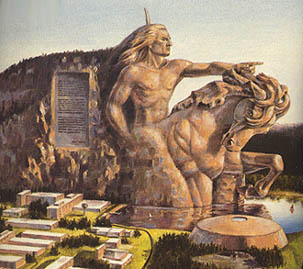

Crazy Horse (1841-1877)
Written and researched by Margaret [nee Knight] Odrowaz-Sypniewska, B.F.A.

Crazy Horse was born in the fall of 1841. His father was Crazy Horse, a respected medicine man of the Hunkpatila band of the Ogala Sioux. His mother was Spotted Tail. Crazy Horse was called "Curly" or "Light-Haired Boy" and his complexion was lighter than that of other Native Americans. When he was about fourteen (14) years of age, General William S. Harney led an assault on his bands encampment, while he was out hunting. When he returned he found eighty-six (86) dead, and many were the women and children. General Harney took seventy (70) females captive. After the death of his friends and relatives, Curly became a foe of the white man (understandably so). In 1858 (at age 17) Curly rode with a war party against the Arapahos of central Wyoming. The Arapahos defended their village from behind some boulders on a hillside. Curly decided to ride into the fray and counted coup on two Arapaho warriors. Twice more he charged the enemy and when they confronted him he killed them both with his bow and arrows. After this event, he was renamed "Crazy Horse" after his father. This was a common name among the Sioux.
Crazy Horse was a member of a medicine society called the Thunder Cult, and he sought visions to guide his people.
In 1865, Crazy Horse had counted up to 240 coup. He was then made chief of the Oglalas. In Plains warfare bravery was noted by the "counting of coup." An eagle feather was awarded to the warrior for each coup. If the enemy was armed and a warrior killed him and took his scalp, a brave received three coup feathers. Capturing an enemies possessions such as his own eagle feathers, brought him great honor. Crazy Horse played an important role (under Sitting Bull) in the harrassing of a 2,000 man column of soldiers lead by Colonel Nelson Cole and Lt. Samuel Walker. He fought in Red Cloud's War in 1866. On December 6, 1866, during a fight near Fort Phil Kearney, Crazy Horse ambushed another detachment of soldiers. By Decmber 21, 1866, his warriors stationed temselves on the road noth of Fort Phil Kearney and three some soldiers away from the fort to make chase. Then his ten decoys (2 Cheyenne warriors, two Arapaho, and two each of Ogala, Brule, and Minniconjou Sioux) appeared in front of the post. The fort artillery sent the decoys off as though they were frightened and Capt. William F. Fetterson was quoted as saying: "with 80 men I could ride through the Sioux Nation." Concealed braves launched a barrage of 40,000 arrows and all 81 soldiers were killed or mutilated.
One observer to this battle was private John Guthrie. He reported the following:
All the Fetterman boys huddled together on a small hill ... They were mutilated, stripped naked, with crushed skulls and ears, noses, and legs were cut off. Their scalps were torn away. Sgt. Baker of Company C 2nd Cavalry had a sack over his head, and his little finger was cut off in order to take his gold ring. Their entrails lay in the high grass.
On August 2, 1867, Crazy Horse tried the same tactics on some woodcutters near Fort Kearney. He was reconfirmed as the chief of the Ogalas. In the 1873, in a battle against General George Armstrong Custer's soldiers, Custer's horse was shoot from under him. Crazy Horse (Tashunca Utico/Tashunka Witka) was a chief that was associated with both Gall and Sitting Bull. In 1876, the army sent three large groups of soldiers against the Sioux and Cheyenne. The first attack was on June 17, 1876 at Montana's Rosebud River. This was where General George Crook's column of 1,300 men met an army of Native Americans of equal numbers. They drove Crook's army back to their camp.
On June 25, 1876, Crazy Horse lead an attack on Custer and his 7th Cavalry. This was at the "Battle of Little Bighorn" or "Custer's Last Stand." In the aftermath of Little Bighorn, Crazy Horse did not take his band to Canada, as did Sitting Bull, Gall, and others, but he remained in Montana to continue fighting the army's forces under the command of Col. Nelson A. Miles. By 1877 the buffalo was almost extinct and his starving people were put on the reservation. Crazy Horse had battled many soldiers but had still not managed to put a stop to the occupation of more and more whites to his native home. After discovering that resistence was futile, Crazy Horse surrendered to Col. Miles in May 1877. He was arrested on September 5, 1877. After that Crazy Horse was taken to Fort Robinson, Nebraska, where he was to be confined as a prisoner. Not wishing to be locked up like an animal, Crazy Horses resisted, and was killed by a bayonet thrust through his kidney. This scuffle was with a group of soldiers and Indian police. Crazy Horse died at age thirty-six (36) years of age. Which one of the men delivered the killing blow to Crazy Horse is not certain.
Crazy Horse's parents recovered his body and buried him in a secret place.
SOURCES:
Cruthfield, James A., Bill O'Neil, and David L. Walker. Legends of the Wild West. Lincolnwood, IL.: Publications International, Ltd., 1995.
Hirchfelder, Arlen and Paulette Moon. An Encyclopedia of Native American Religions. New York: Facts on File, 1992.
Newman (editor), Marc. Indian Chiefs of the Old West Card Game. Stamford, Connecticut: U.S. Games System, Inc.
Time-Life Books. The Wild West. New York: Warner Books, 1993
Waldman, Carl. Encyclopedia of Native American Tribes. New York: Facts on File Publications, 1988.
LINKS:
Email Margaret: Margaret
This page was last updated on April 4, 2016
